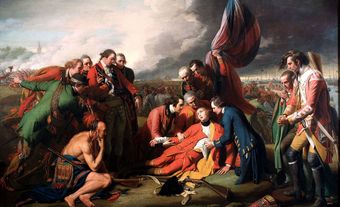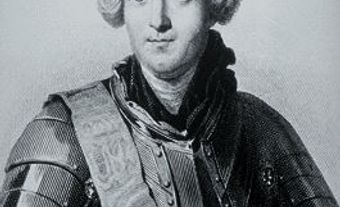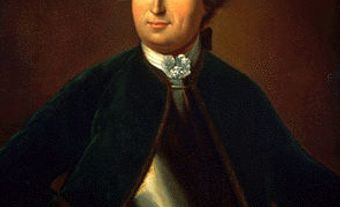Jean Vauquelin, French sailor and naval officer (born in February 1728 in Dieppe, France; died 10 November 1772 in Rochefort, France). A skilled sailor from an early age, he first distinguished himself as a merchant marine captain and, later, as a naval officer during the Seven Years’ War. His composure, daring and skill as a commander were noted during the sieges of Louisbourg in 1758 and Quebec City in 1759 and 1760.

Definitions
Commoner – Person who is not a member of the nobility.
Privateer – Privately-owned, armed merchant ship authorized by the government to attack ships from other countries.
Ship’s boy – Young boy learning seamanship.
Young Sailor
Little is known about Jean Vauquelin’s childhood. He was born in 1728 in Dieppe, a port city in the north of France. At approximately 12 years of age, he began sailing with his father, a shipowner invested in trade with the West Indies, who taught him the basics of navigation and the challenging life on board a privateer. While he may seem young for such a life, it should be remembered that, in the 18th century, it was generally at approximately that age that young French boys (who were often sons of sailors) hired themselves out as ship’s boys on merchant ships. Jean Vauquelin grew up in that maritime world and quickly proved himself to be a skilled navigator. Thus it was that, on the eve of his 20th birthday, he became an officer on an armed frigate during the War of the Austrian Succession (1740–1748).
Once the hostilities were over, Jean Vauquelin assumed the captaincy of a merchant ship. When the Seven Years’ War (1756–1763) broke out, he was recruited by the naval commander in Le Havre to serve as an officier bleu, a name given to commoners recruited from the merchant marine during the 18th century to serve (on a temporary basis) in the French Royal Navy. Their counterparts, the officiers rouges, were members of the nobility.
Siege of Louisbourg 1758
In 1758, Jean Vauquelin was given the rank of Frigate Lieutenant. He commanded the Aréthuse, a 30-gun frigate attached to the vessels responsible for supplying the fortified town of Louisbourg, the capital of the French colony of Île-Royale. The fort was then under siege and blockaded by a large British force composed of a squadron of 40 fighting ships and 150 transport vessels.
Against all expectations, Jean Vauquelin successfully ran the blockade and sailed into Louisbourg on 9 June, where he was an active participant in its defence. Anchored in the port, the Aréthuse significantly hampered the maneuvers of the enemy with heavy fire. Despite the French defeat, Jean Vauquelin’s actions were both noticed and praised by his superiors, all of whom stressed ″the decisiveness and composure with which [Captain] Vauquelin, who commanded this frigate, countered the enemy fire and bombs in the port he was assigned to protect.”
In July 1758, given the perilous situation in Louisbourg, Governor Augustin de Boschenry de Drucourt gave Jean Vauquelin permission to return to France. Once again, Jean Vauquelin succeeded in slipping through the blockade of British ships. He outran his pursuers, crossed the Atlantic Ocean and arrived in France following a rapid crossing which earned him the congratulations of the Minister of Marine, Nicolas René Berryer. (See also Ministère de la Marine.)
The Duchess of Mortemart, fascinated by the story of Jean Vauquelin’s exploits, requested that Minister Berryer grant him a promotion. While the Minister recognized that Vauquelin was a hero, he was not a member of the nobility. Thus, despite his exploits, Jean Vauquelin was not promoted to Captain because he was a commoner.
Siege of Quebec City 1759
In May 1759, Jean Vauquelin returned to Canada as the commander of the frigate Atalante, a 34-gun ship. He escorted a convoy of three ships carrying supplies to Quebec City, arriving only a few days before the British forces coming to besiege the city under the command of Major-General James Wolfe. The British troops were transported by a powerful 186-ship naval force, including 49 warships. The remainder of the force consisted of hospital ships and ships transporting troops and supplies.
Upon his arrival in Quebec City, Jean Vauquelin was placed in charge of defending the port by Gouvernor Pierre de Rigaud de Vaudreuil de Cavagnial. He was also responsible for inspecting the gun batteries in the city’s fortifications. In the battles fought during the 18th and 19th centuries, it was customary to give naval officers artillery-related tasks. The nature of their duties and war at sea made naval officers especially capable in this regard.
Jean Vauquelin carried out his mission with his usual energy. However, his rivalry with Captain Jacques Kanon led to the failure of his efforts to coordinate the French naval forces before Quebec City. A favourite of the Purveyor-general to the French forces in Canada, Joseph-Michel Cadet, Jacques Kanon wielded a great deal of influence in Quebec City. At one point, he even refused to serve under Jean Vauquelin, whose rank was, in fact, higher than his own. Eventually, the Quebec City defenders could no longer hold out against the British invasion and the city capitulated on 18 September 1759, several days after the Battle of the Plains of Abraham.
In the spring of 1760, Jean Vauquelin assembled a small fleet, consisting of the Atalante, the Pomone, the Pie and several light craft and accompanied the army of François-Gaston de Lévis, which was en route to retake Quebec City. Despite being victorious at the Battle of Sainte-Foy on 28 April 1760, the French were unable to retake the city and abandoned the siege following the arrival of British ships sent to its aid. On 16 May, the Atalante (34 guns) was pursued by the British ships Lowestoft (28 guns) and Diana (32 guns). Jean Vauquelin covered the withdrawal of the transport vessels that accompanied him and led the enemy further away, to Pointe-aux-Trembles (Neuville). Despite being at a disadvantage, he put up fierce resistance and evacuated his crew to the river bank under unrelenting fire. According to a May 1760 military report, Jean Vauquelin fought under British fire for two hours without lowering the king’s flag. Out of ammunition, he was taken prisoner. A fair number of officers and crew members were killed or wounded.
End of Career
Jean Vauquelin’s tenacity made a strong impression on his adversaries. James Murray, the commander of Quebec City, considered him to be an exceptional fighter ─ so much so that he was quickly released and returned to France. Following his return, Jean Vauquelin continued his career in the French Royal Navy and attained the rank of Lieutenant-commander in 1761. He commanded a number of ships, such as the Bricole, the Coulisse and the Garonne, which took him as far as the Indian Ocean.
In December 1769, Jean Vauquelin was accused of illicit trading, specifically, of trading in black slaves. (See also Black Enslavement in Canada.) A royal order sentenced him to be imprisoned for three months in the Château du Taureau. Transferred to Nantes, he was not freed until 1 May 1770. In August 1772, he was given command of the Faune; however, his health suddenly deteriorated. Three months later, Jean Vauquelin died of his illness in Rochefort.
Legacy
The life of Jean Vauquelin is representative of that of a number of officers in the 18th century who distinguished themselves through their bravery, but whose birth as commoners prevented them from fulfilling their ambitions in the French society of the Ancien Régime. (See also Seigneurial System.) His exploits have inspired many Canadian authors. Some, like Faucher de Saint-Maurice and poet Louis Fréchette, succumbed to the temptation to elevate his story to the status of a legend. Others, such as Aegidias Fauteux and Gustave Lanctôt, drew a more nuanced portrait, which was undoubtedly closer to reality. A statue of Jean Vauquelin was erected on 22 June 1930 in Montreal, across from the monument dedicated to British Admiral Horatio Nelson.


 Share on Facebook
Share on Facebook Share on X
Share on X Share by Email
Share by Email Share on Google Classroom
Share on Google Classroom


